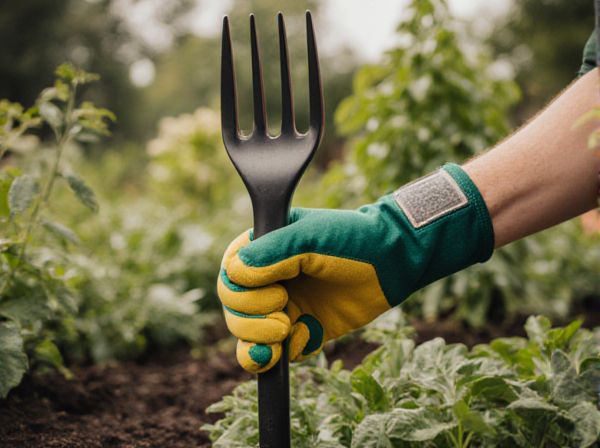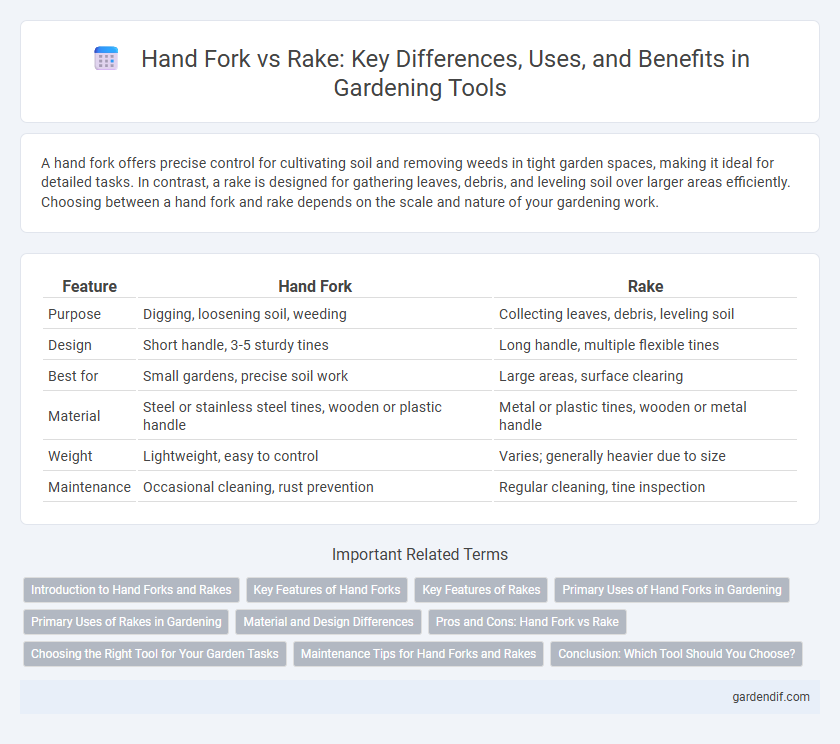
Hand Fork vs Rake Illustration
A hand fork offers precise control for cultivating soil and removing weeds in tight garden spaces, making it ideal for detailed tasks. In contrast, a rake is designed for gathering leaves, debris, and leveling soil over larger areas efficiently. Choosing between a hand fork and rake depends on the scale and nature of your gardening work.
Table of Comparison
| Feature | Hand Fork | Rake |
|---|---|---|
| Purpose | Digging, loosening soil, weeding | Collecting leaves, debris, leveling soil |
| Design | Short handle, 3-5 sturdy tines | Long handle, multiple flexible tines |
| Best for | Small gardens, precise soil work | Large areas, surface clearing |
| Material | Steel or stainless steel tines, wooden or plastic handle | Metal or plastic tines, wooden or metal handle |
| Weight | Lightweight, easy to control | Varies; generally heavier due to size |
| Maintenance | Occasional cleaning, rust prevention | Regular cleaning, tine inspection |
Introduction to Hand Forks and Rakes
Hand forks and rakes are essential gardening tools designed for soil cultivation and debris removal. A hand fork features short, sturdy tines ideal for loosening compacted soil, aerating small garden beds, and uprooting weeds. Rakes, with longer tines or teeth, efficiently gather leaves, grass clippings, and other garden debris while also leveling soil surfaces.
Key Features of Hand Forks
Hand forks feature sturdy, short tines designed for precision digging, weeding, and loosening soil in tight garden spaces. Their ergonomic handles provide comfort and control, reducing hand fatigue during prolonged use. Unlike rakes, hand forks excel in breaking compacted soil and aerating around plants without disturbing root systems.
Key Features of Rakes
Rakes feature a series of long, flexible tines designed for gathering leaves, grass, and garden debris efficiently across large surfaces. Their wide head and sturdy handle provide leverage and reach, making them essential for soil leveling and debris collection. Unlike hand forks, rakes cover more ground quickly, optimizing lawn and garden maintenance.
Primary Uses of Hand Forks in Gardening
Hand forks excel in aerating compact soil, breaking up clumps, and removing weeds in confined garden beds. Their sturdy tines allow precise cultivation around delicate plants without causing damage. These tools are essential for transplanting seedlings and mixing soil amendments in small-scale gardening tasks.
Primary Uses of Rakes in Gardening
Rakes are primarily used in gardening for gathering leaves, grass clippings, and debris, making yard cleanup efficient. They also help in leveling soil and spreading mulch evenly across garden beds. Unlike hand forks, rakes cover larger areas quickly, facilitating soil preparation and garden maintenance.
Material and Design Differences
Hand forks typically feature durable stainless steel or carbon steel tines that resist rust and provide strength for digging in compact soil, while rakes often use lightweight aluminum or flexible plastic tines suited for gathering leaves and debris on various surfaces. The hand fork's design includes three to four short, sturdy tines allowing precise soil aeration and weeding, contrasting with the rake's longer, wider head equipped with multiple tines arranged to cover larger areas efficiently. Material choices and ergonomic handle designs further differentiate these tools, with hand forks offering reinforced wooden or fiberglass handles for control, and rakes utilizing extended wooden or metal handles to maximize reach and leverage.
Pros and Cons: Hand Fork vs Rake
A hand fork offers precise soil aeration and weed removal in tight spaces, making it ideal for small garden beds, but it requires more physical effort and time compared to a rake. A rake covers larger areas quickly, excels at gathering leaves and debris, yet can be less effective for deep soil cultivation or working around delicate plants. Choosing between a hand fork and a rake depends on garden size, plant type, and the specific gardening task at hand.
Choosing the Right Tool for Your Garden Tasks
Hand forks excel at loosening soil and removing weeds in tight garden spaces, offering precise control for delicate tasks. Rakes efficiently collect leaves, grass clippings, and debris while leveling soil surfaces across larger areas. Selecting the right tool depends on the specific garden task, soil type, and area size for optimal maintenance and plant health.
Maintenance Tips for Hand Forks and Rakes
Regular cleaning of hand forks and rakes immediately after use prevents rust and extends tool lifespan. Sharpen hand fork tines periodically with a file to maintain efficiency in digging and aerating soil. Store tools in a dry, sheltered area and apply a light coat of oil to metal parts to protect against moisture and corrosion.
Conclusion: Which Tool Should You Choose?
Choosing between a hand fork and rake depends on the specific gardening task and soil condition. Hand forks excel in loosening compact soil and removing weeds in tight spaces, while rakes are ideal for leveling soil, gathering debris, and spreading mulch over larger areas. For precise cultivation and root aeration, opt for a hand fork; for surface work and debris management, a rake is more efficient.
Hand Fork vs Rake Infographic

 gardendif.com
gardendif.com